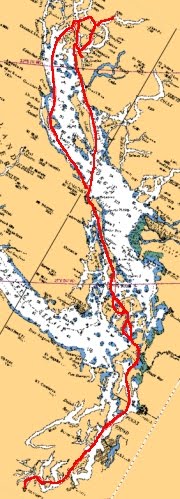 |
| Click to expand |
Of course one of the reasons to go to the Broughtons is for seafood. You can find good salmon fishing here - chinook, coho, and pinks. You can find good bottom fishing here for halibut, ling cod, and yelloweye rockfish (red snapper) and more. Much of the area is protected by Rockfish Conservation Areas (RCAs) so you will need to consult a DFO pamphlet prior to fishing. There's wonderful shrimping to be found in many of the inlets, and if you're a scuba diver you can get rock scallops too. There are many incredible scuba diving locations. Some of the best scuba diving on the planet can be found here. If you're interested in scuba diving check out my good friend Steve Lacasse from Sun Fun Divers in Port McNeill.
If going for a walk is also part of your adventure there's plenty of hikes to be had too. In Greenway Sound you can hike up to Broughton lake for a refreshing swim. The BC Forest Service has several established areas for hiking at Turnbull Cove, Moore Bay, and Greenway Sound. We have also simply hiked on the many abandoned logging roads for a refreshing hike - just stay away from active logging areas.
If you're into learning about the area's history, a stop in Alert Bay to visit the U'mista Cultural Museum is a must. You can visit other native sites such as Mamalilaculla, Karlukwees, Matilpi, and Heath Bay but remember these sites are private property and must be treated with absolute respect. If in doubt ask for permission to visit these locations. Often a guide will be present to tell you about the area. If you look hard you can find pictographs on the rocks of Vancouver's long ago visit in some remote bays.
Here's some of our favorite spots:
 |
| Click to expand |
- Carriden Bay, Grappler Sound
- Crease Island, Village Islands Group, Knight Inlet
- Baker Island Bight, Fife Sound
- Joe Cove, Eden Island, Fife Sound
- Prawns from Kingcome Inlet
- Indian Passage, Fife Sound
- Turnbull Cove, Grappler Sound
- Spring Passage
- Cullen Harbor, Fife Sound
If you're going to visit the Broughton's I suggest you make Port McNeill your base. There's a great marina there, groceries, fuel, and supplies to be had. It's about 4 hours drive by car from Nanaimo if you plan to have guests visit you. Many float planes service Port McNeill and the area from Seattle and Vancouver. Might I suggest that from Port McNeill you make a "circle route" to do your Broughton's exploration. You will need CHS Charts 3547 & 3515. Start by visiting the islands in and around Blackfish Sound & the Village Group, then cross Knight Inlet into the Baker-Insect-Eden Island archipelago by Fife Sound, then to the Burdwood Group & Fife Sound, then to Sutlej Channel going up to Grappler Sound & the many anchorages there, and finally out Wells Passage crossing Queen Charlotte Strait ending at Port McNeill. We've done this "circle route" many, many times. Future posts will describe some of the above locations and anchorages in greater detail. If you have questions regarding the above area, don't be afraid to leave a comment and I will try to respond.
We enjoy fresh caught rockfish (Quillback, Black, Copper, etc.) a lot. Here's a favorite MV Independence recipe we invented over the many years while cruising in the Broughton's. We call this dish, "Rockfish Mediterranee." I hope you enjoy it as much as we do.
Ingredients:
- 2-4 rockfish fillets
- 2 tbsp butter
- 2 tbsp onion, chopped
- 1 tsp garlic, chopped
- 1 cup tomato chopped
- 1 tbsp capers
- 3 tbsp green olives with pimentos, sliced
- 1 tsp dried oregano
- 1 tsp dried basil
- 1 tsp lemon juice
- 2 tbsp sweet vermouth or Japanese mirin
- 1 tsp Cajun seasoning
- 4 cups cooked pasta












